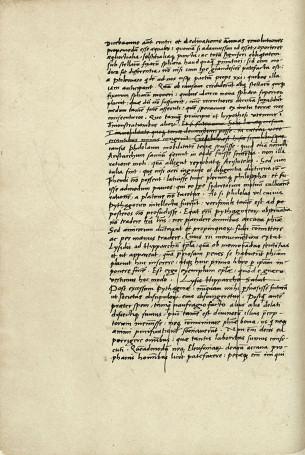His interest in astronomy and in the humanities called for mastery of ancient Greek.
Copernicus could have learnt his first Greek characters in Kraków but it was not until he started attending classes given by the famous Antonius Urceus Codrus (known as Codro – d. 11 Feb. 1500) in Bologna that he started learning Greek in a more systematic way. Codro was a friend of the renowned Venetian printer and humanist Aldus Manutius (1449–1515) whose publications included the Greek grammar by Theodore Gaza (1495) and a collection of works by Greek epistolographers called Aldina (1499), edited by the Cretan Marco Musuro (1470–1517) a disciple of Konstantinos Laskaris (1434–1501). Among works by over thirty writers, Aldina included Letters: moral, rustic and erotic (Epistolae morales, rurales et amatoriae) by the Byzantine writer and man-of-letters Theophylact Simocatta (b. ca 560).
Copernicus must have taken great interest in the Letters because he took the trouble of buying and later translating them into Latin. It is not certain whether he had purchased the entire volume of Aldina or only a separately published selection containing those 85 fictitious letters. Nor do we know the exact date the book was purchased. Most probably he bought it between 1501 and 1503 while in Padua where he also acquired a Greek-Latin dictionary (published in Modena in 1500) but written by Joannes Crastonus (d. 1475) which he used extensively while studying the language and literature of the ancients.
While attending lectures given by Lorenzo da Camerino of Crete (Leonico also known as Cretico) Copernicus must have gained some knowledge not only of works by authors included in Aldina but also of former translations of Greek letters attributed to Falaris, tyrant of Sicily (sixth century BC); to Julius Caesars assassin Mark Iunius Brutus; and to Crates of Thebes, reputedly belonging to the ancient School of Cynics. In Padua the person responsible for explicating Greek texts by Plato and Aristotle was the Venetian Niccolò Leonico Tomeo (1456–1531). It can be assumed that Copernicus was one of his students.
At the end of his stay in Italy, the Frombork canon visited Alduss grand publishing house and bought another book there: In calumniatorem Platonis by Cardinal Bessarion which included the first Latin translation of the Pythagorean letter from Lysis to Hipparchus (known from Aldina) discussing the need to reserve the secrets of knowledge to a small circle of the chosen. Apparently, Copernicus was not satisfied with the translation and made his own which he included in his manuscript of De revolutionibus. The astronomer finally gave up the idea of publishing the letter and therefore it is not included in the early editions of 1543, 1566 and 1617. It was not until the 19th c., when his forgotten text surfaced in Prague, that Copernicus scholars were able to take a closer look at his version which first appeared in print in the Toruń edition of De revolutionibus in 1873.
A Greek and Latin epigram written in honour of Johannes Dantiscus (Johann Hoefen) ca 1512 is also a manifestation of Copernicus literary interests. Although it was meant to introduce the Epithalamium written by Dantiscus on the occasion of the wedding of King Sigismund and Barbara Zapolya, it did not appear in print until three-hundred years later. The epigram was first published in 1855 from a handwritten copy made by a scholar from Kraków, Joannes Broscius (Jan Brożek).
 English (United Kingdom)
English (United Kingdom)  Polski (PL)
Polski (PL) 






